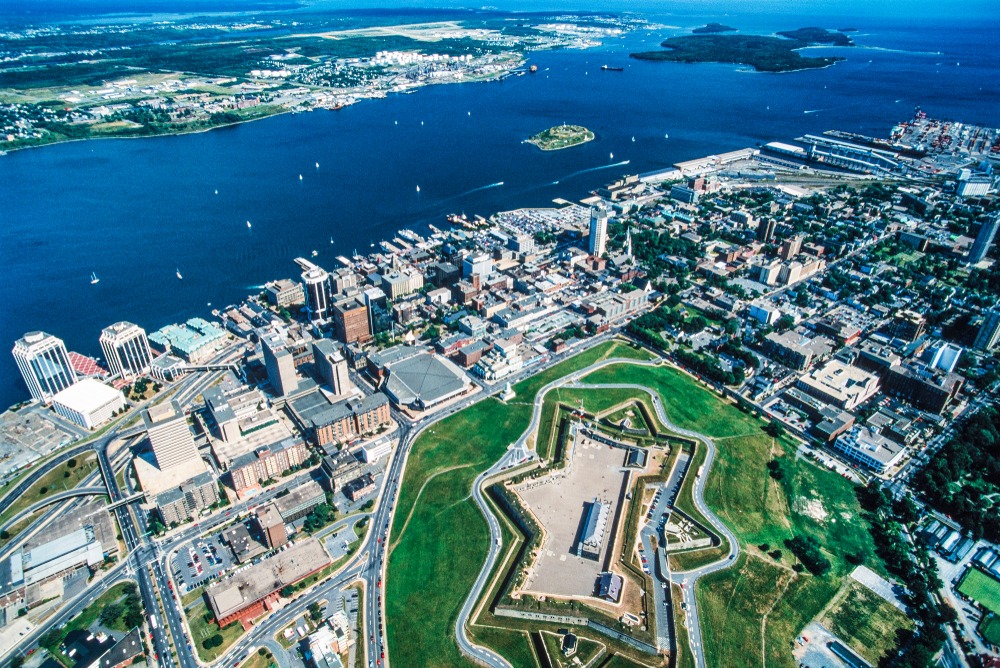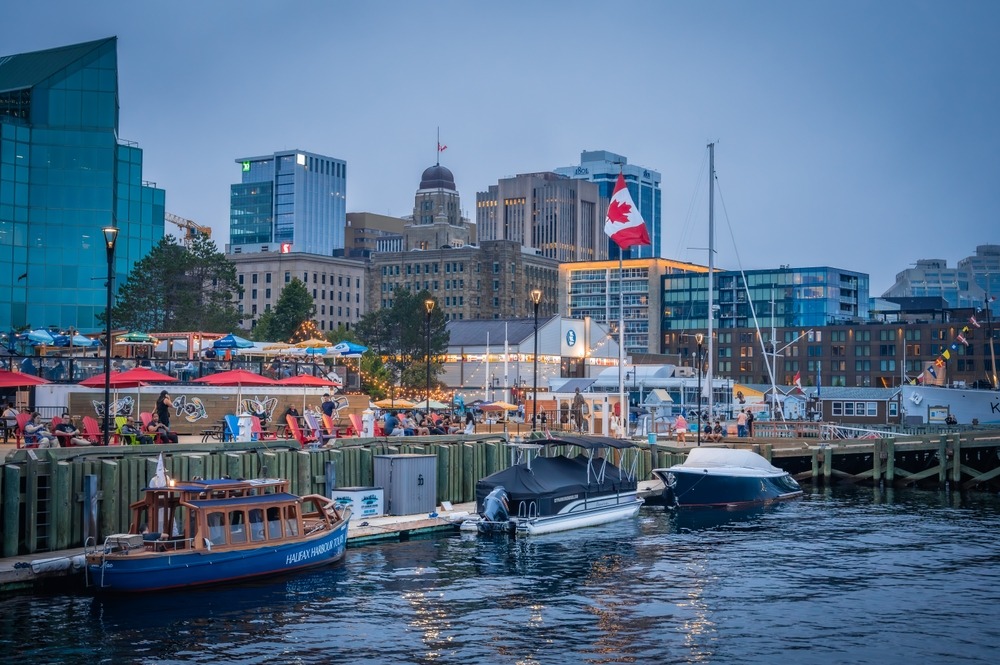History of Halifax, Nova Scotia
Perched on one of the world’s largest natural harbors, Halifax is the capital of Nova Scotia and a city where coastal charm meets military legacy, maritime tragedy, and Canadian cultural pride. With deep Indigenous roots, colonial conflict, and resilient rebuilding, Halifax’s story is one of survival, reinvention, and strategic importance.

Mi’kmaq Lands and Early Contact
Long before European ships arrived, the Mi’kmaq people lived in and around the area known as Kjipuktuk (“Great Harbour”). This region offered rich fishing grounds, forests, and transportation via inland rivers and the Atlantic. The Mi’kmaq had an extensive and sustainable culture, with seasonal camps and vast trade networks across the Maritimes.
Founding of Halifax (1749)
The British founded Halifax in 1749, under the command of Edward Cornwallis, as a counterbalance to the French stronghold of Louisbourg on Cape Breton Island. This military move intensified tensions with both French settlers (Acadians) and the Mi’kmaq, who resisted British expansion on their ancestral lands.
The British built Fort George (later Citadel Hill) and rapidly developed Halifax as a key naval and military base. The harbor’s strategic position made it a center of colonial military logistics and Atlantic defense.
Naval Power and 19th-Century Growth
By the 19th century, Halifax had grown into one of the British Empire’s most important Atlantic ports. It served as a shipping center, fishing hub, and base for the Royal Navy’s North Atlantic Squadron. Halifax was the first entry point for immigrants arriving in Canada and became a bustling urban center of trade and maritime culture.
The city played a vital role during both World War I and World War II as a convoy hub, troop staging point, and supply depot.

The Halifax Explosion (1917)
One of the most defining—and devastating—events in Halifax’s history occurred on December 6, 1917, when the SS Mont-Blanc, a French cargo ship laden with explosives, collided with another vessel in Halifax Harbour. The resulting blast was the largest man-made explosion prior to the atomic bomb, leveling neighborhoods, killing nearly 2,000 people, and injuring over 9,000.
This tragedy triggered unprecedented relief efforts, including aid from Boston—a bond still honored today during Halifax’s annual Christmas tree gift to the city of Boston.
Modern Halifax
Halifax became the capital of the newly formed province of Nova Scotia in 1867, the same year of Canadian Confederation. In recent decades, the city has emerged as a center for education, defense, and culture, home to multiple universities, a thriving arts scene, and a growing tech and startup industry.
Today, Halifax blends historic charm with modern energy, offering a unique fusion of old fortifications, salty sea breezes, vibrant festivals, and warm East Coast hospitality.
Top 25 Attractions in Halifax, Nova Scotia
1. Halifax Citadel National Historic Site
A star-shaped fortress overlooking downtown, where you can witness cannon firings, explore military exhibits, and interact with costumed interpreters.
2. Halifax Waterfront Boardwalk
A scenic 4-km path along the harbor filled with shops, restaurants, museums, and sea views—perfect for walking, cycling, or just soaking in the maritime spirit.
3. Maritime Museum of the Atlantic
Showcasing Nova Scotia’s rich nautical heritage, including Titanic artifacts, a deep dive into the Halifax Explosion, and exhibits on naval warfare.
4. Canadian Museum of Immigration at Pier 21
Once the gateway for nearly 1 million immigrants to Canada, this moving museum shares stories of migration and identity.
5. Alexander Keith’s Brewery Tour
Visit one of North America’s oldest breweries (founded in 1820) for an entertaining and theatrical tour—complete with tastings and songs.
6. Halifax Public Gardens
A Victorian-era public park with ornate fountains, winding paths, rare trees, and seasonal flower displays in the heart of the city.
7. Point Pleasant Park
A wooded, coastal retreat at the city’s southern tip offering ocean views, trails, historic ruins, and dog-friendly areas.
8. Art Gallery of Nova Scotia
Home to works by local and national artists, including a dedicated exhibit to famed folk artist Maud Lewis.
9. The Old Town Clock
An iconic landmark atop Citadel Hill, built in 1803, offering views over downtown and a symbol of Halifax’s colonial past.
10. Province House
The oldest provincial legislative building in Canada, still in use, with neoclassical architecture and guided tours.
11. The Discovery Centre
A science and innovation museum perfect for families, with interactive exhibits on space, technology, health, and energy.
12. Halifax Seaport Farmers’ Market
Canada’s oldest continuously operating market (since 1750), now housed in a modern waterfront space offering crafts, food, and music.
13. Ferry to Dartmouth
Take North America’s oldest continuously operating saltwater ferry across the harbor for panoramic city views and exploration of Dartmouth.
14. St. Paul’s Anglican Church
Built in 1750, it’s the oldest Protestant church in Canada and miraculously survived the Halifax Explosion with visible shrapnel still embedded in its walls.
15. The Hydrostone Market
Located in a stylish neighborhood rebuilt after the 1917 explosion, filled with artisan shops, cafes, and European-style charm.
16. Fairview Lawn Cemetery
Final resting place of over 100 Titanic victims, with interpretive plaques and the famous “J. Dawson” headstone.
17. Halifax Central Library
An architectural marvel and community hub with rooftop views, reading lounges, cafes, and cultural events.
18. Casino Nova Scotia
Offering entertainment, gaming, and live music along the harbor for those looking for nightlife excitement.
19. York Redoubt National Historic Site
A historic fort built in 1793 guarding the entrance to the harbor, with hiking trails and ocean views.
20. Halifax Harbour Hopper Tour
A land-and-sea amphibious tour offering fun and quirky history lessons from a bright green WWII-era vehicle.
21. Museum of Natural History
Learn about Nova Scotia’s wildlife, geology, and cultural traditions, including a live display of local turtles and Gus the gopher tortoise.
22. McNabs Island
Accessible by boat or kayak, this island park offers trails, beaches, and ruins of 19th-century military installations.
23. Emera Oval
A large outdoor skating rink in winter (and rollerblading/biking track in summer) located on the Halifax Commons.
24. Neptune Theatre
Atlantic Canada’s largest professional theatre company, offering plays, musicals, and new Canadian works in an intimate venue.
25. Garrison Grounds and Summer Festivals
A sprawling lawn next to Citadel Hill hosting outdoor concerts, Canada Day events, food fests, and cultural celebrations.

Conclusion
Halifax is a city that rises from the sea with a sailor’s heart and a soldier’s soul. Its history is anchored in naval might, immigration, and resilience, while its present pulses with art, music, innovation, and deep community spirit. Whether you’re walking the boardwalk at sunset, stepping inside a 19th-century fort, raising a glass at a historic brewery, or learning about Titanic passengers and wartime heroes, Halifax invites you to immerse yourself in stories—both tragic and triumphant—set against the endless rhythm of the Atlantic tides.

































